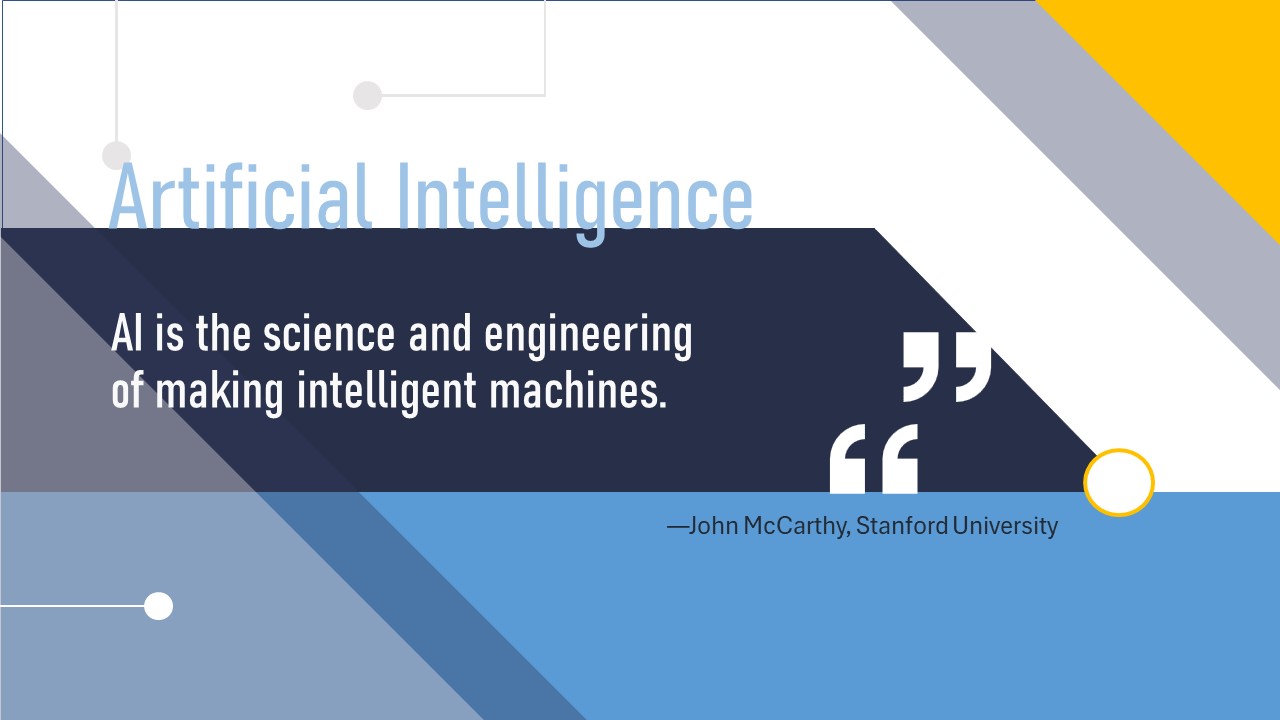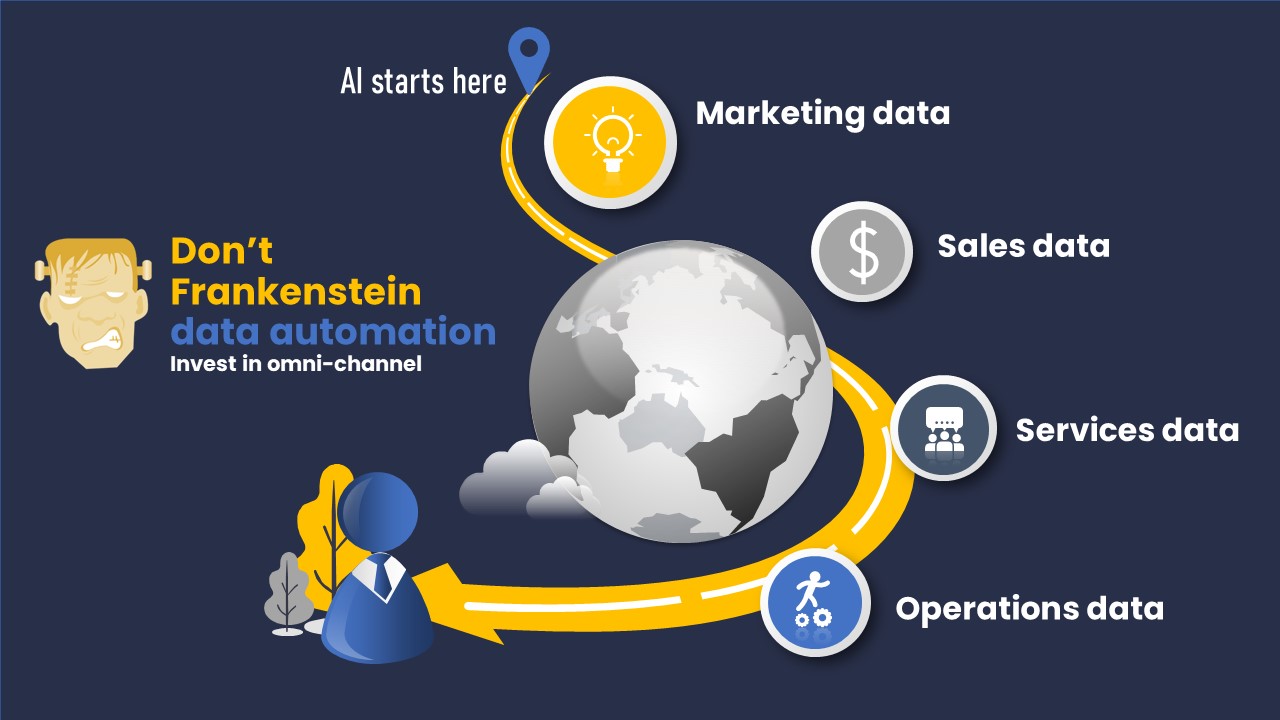Sci-fi is the new normal: AI is here
data activation | HubSpot for associations | AI for associations
Bicentennial Man. AI Artificial Intelligence. Ex Machina. iRobot. Meghan. What do these movies all have in common? Yep, you’ve got in. They’re all sci-fi films with artificially intelligent characters. Some were predicting AI before today’s AI architects were even born. Let that sink in.
So were the writers and directors geniuses? Were they clairvoyant? Particularly for earlier movies like Short Circuit? Or were they just early innovators and visionaries without the tech that we have now? My opinion—while they had the big ideas back then, the natural evolution of tech needed to happen in order to get to AI.
And it is here. The magic that is AI is no different than the plots in our sci-fi and fantasy films. It’s inevitable. It’s the writing on the wall. AI tech is moving at an accelerated pace. Sci fi has been normalized in our every day.
Earlier this month, I had the pleasure of attending DigitalNow, which decoded the sorcery of AI specifically for associations. The event was nothing short of a fiery, flying heap of “overwhelming excitement” all at once. The event amassed “the real” on AI technologies, use cases, risks, and frameworks. Distilling it wasn’t easy  but here’s what I gleaned for associations:
but here’s what I gleaned for associations:
It isn’t going away
In fact, it’s growing exponentially. It has forever changed the face and capabilities of software and tech. Industries, organizations, and expectations, continue to reshape as AI is woven into every nick and cranny of today’s business and tech stacks. Associations are no exception to the rule.

It’s the ‘yin’ to our ‘yang’
When you think about how humans learn, yes there are a ton of definitions out there but, in the most precise way, humans learn through experience, categorization, and connection. Now think about that. We used—and continue to use—our learnings to create AI, which is essentially the science of making machines smart. So this wave of tech can be nebulous to us but it's rooted in everything that we think and do as humans. This symbiosis is a good reminder for AI adoption.

Data is its DNA
AI’s diet is made-up of the most nutritional digital asset out there—data. Artificially intelligent machines are made smarter by continual interaction with data sets. Through it, AI—in its own way—experiences, categorizes, and makes connections just like we do.
Difference being, where we have emotion, AI has power. Where we have empathy, AI has speed. So yes, could we do the majority of things that AI could do? Of course. Can we do it at the same clip with the same efficiency and capability? Not at all. Does AI have an algorithm for empathy? Does it have a semblance of an EQ? Not at all.
In the end, they’re really just mirrors of our language and learnings. So it only makes sense that humans and their AI counterparts work together. Speed and power combined with emotion and empathy, particularly as it relates to business, is quite the force.
It’s multi-talented
There are hundreds of tools out there right now in the AI space. As an association, you don’t need to know all of them. Not even close. The best use of your time is to understand what AI can do so that you can best align the right tech with what your organization needs. Keeping in mind that, in most cases, you're already a card carrying holder of tech with AI natively built-in.

Categorically understanding AI is a good way to get to know what it does, and how it can help your organization. So let's start with the AI family:
1—Machine learning | AKA The Grandfather
Machine Learning, the most senior AI category, is built on algorithms that breath data and models to enhance performance. Think of Grandfather Gary who smokes his pipe in his distressed leather recliner and tells stories of the past to relay important life learnings to his grandchildren. This is Machine Learning.
Machine Learning use cases for associations could include:
- ChatBots supporting member recruitment or member services' efforts
- AI-generated content recommendations for member subscriptions
- Language translations for global organizations
2—Generative AI | The Art Student Granddaughter
Generative AI is exactly how it sounds. It has the ability to generate net new assets, including content, messaging, imagery, audio/video, you name it. Think of granddaughter Alex, who currently attends The Chicago School of Art Institute. She’s teeming with creativity, and is constantly reinventing her look, her outlook, and her artwork. She's so held to revival that she'll more than likely drop out of school to rid herself of traditional academic conventions.
Common applications for the tortured creative of the family:
- Generating: Synthesizes and creates brand new content, images, videos, etc. (think blog posts, brand logos, landing page imagery)
- Extracting: Condenses swarms of content into simple terms (think meta descriptions, presentation outlines, content clusters)
- Summarizing: Simplifies information for easy consumption (think mission statements, bios, member engagement survey open-ended feedback).
- Classifying: Compartmentalizes information to organize content, topics, audiences, behavioral needs (think Content Libraries, Email Preference Center taxonomy, conference tracks)
- Rewriting: Creates content accessibility by breaking down complex concepts or even freshening up tone and voice (think conference session abstracts, eLearning descriptions)
- Reviewing: Audits information, strategies, and vehicles to provide recommendations and assessments (think web site optimization)
3—Predictive AI | The Financial Analyst Uncle
Predictive AI looks at data, patterns, and trends to forecast outcomes of the future. In the association ecosystem, this allows marketers, program owners, and leaders to make intelligent business decisions on audiences, membership models, programmatic offerings, and even industry projections. Think of Uncle Fred, Financial Analyst at Deloitte, who leases out a new car every six months, has no kids, and is consistently trying to give his siblings financial advice.
Here are some use common use cases for the fortune teller of the family:
-
Personalized recs on programs and content based on past selections
-
Insights that drive new program and product development
-
Lead and engagement scoring for prospects and members
Now that you've met the family, here's some functionality to really press home for associations looking to adopt AI for growth and efficiency:
It can unlock dormant content
Associations are content machines. They always have been. Where other sectors are just now navigating content creation as part of today's marketing and delivery mechanisms, associations already have this in the bag. But with droves of content accumulating for years, it's easy to let content get lost in the dust. AI is excellent for quickly and effectively activating latent assets so that associations can refresh their marketing inventory and/or set the stage for programmatic digitized content. Which takes us to the next AI value add...
It can monetize content
Associations are now tasked with diversifying revenue away from membership dues and traditional membership models. Exploring different program delivery mechanisms is on the rise. Taking audit of your content, making sense of it, organizing it in a way that's aligned with your core mission, and yes...putting a price tag on it, is the new wave of membership models. Associations are now catering to members via digital libraries, subscriptions, and interactive communities vs. in person handshakes and sessions. Certifications, accreditations, virtual events, and member-based subscription models are all on the docket for incoming association generations.
It can multiply small teams
Once again, AI shouldn't be seen as adversary to your role, your skills, or what you uniquely bring to the table. Think of AI as a multiplier in your organization. Coupling what it can do in terms of asset building and refinement, you can lean on it to just to create efficiency across tasks (think a smart report builder), bounce ideas off of (think ideation sessions and creativity boosts), test concepts and products (think synthetic focus groups), just to name a few.
You can consider it an extension of your team. But like any other team member, it needs the right goal setting, the right language, and the right model to support you in the right way.
It can come with risks
It still needs supervision
Generative AI is typically really good at curating, distilling, and writing. That’s it’s expertise. But, when it comes to your industry, it isn’t the SME, regardless of how much data and content it’s taking in. While, most association users would say that it’s monumentally helpful in providing efficiencies around content generation, it’s still considered a healthy starting point for most depending on what you’re looking to do.
It comes with biases
Because humans have biases, humans are the birthers of AI, and AI is scanning millions and millions of data generated by humans, there are natural biases implanted in AI's output. This is where sensitivity, diversity, and inclusivity—only accomplished by a human—becomes the filtering voice of discretion and reason.
It’s unregulated
Because Artificial Intelligence is so inexorable in it's growth, there's very little precedent. Very little precedent means very little regulation. In fact, while AI output scrapes a lot of copyrighted data, machine-generated content is typically owned by the user leveraging AI. Once the data and assets that are protected get pulled into the machine for re-output, those copyrights are lost. Doesn't make al lot of sense, right?
Associations looking into AI need to be adjacent with responsible AI platforms and technologies. A couple things you need to consider from a privacy and ethical perspective when leaning into AI. You need to:
- Protect your org and your data with trustful clouds
- Invest in secure, privacy-compliant tech stacks built to scale with AI
-
Lean into strategic partners that are either working with you, educating and training you, or putting AI into action on your behalf.
In the end, remember what AI is. Yes, it's a movement that's in full effect right now. Yes, it's most likely not going away. In fact, it's just going to continue getting more powerful. But realistically, these are still tools that are a reflection of us. These are thought partners in the ecosystem under our stewardship. We're still steering the wheel. The better we're in touch with AI, and the more we know how to maneuver it, the better its going to perform.
Before you go on a crusade to scoop up every AI tool you can get your hands on, think about your goals first. Think about what needs you're satisfying from an org and member/customer perspective. Then look for the tool that satisfies the majority of your goals. That's your foundation. Consider it your broth. Once you have your primary tech, then make sure it's friendly with AI plug-ins (consider those your veggies). That way, if you need to fill the gaps, your primary tech can round that out for you.
Keep in mind, a good deal of data automation—AKA omni-channel marketing automation tools like HubSpot—already have AI built into every corner of their systems. That means, everything is connected from a data, effort, and reporting perspective.
Investing in one helps you avoid "Frankenstein" tech stacks. Don't patchwork your tools together. The more consolidated (and even single sign-on) your tech is, the more you'll be able to activate on your data—particularly when it comes to Artificial Intelligence.

Finally, if you take anything away from this blog, remember this—the data you have is the lifeblood of your future. Ensure you have the right tech framework, the right strategies, and the right people in place to continue fueling the engine.
Want to learn more centralizing data to fuel AI?
About Aimee Pagano
Aimee joins HighRoad Solution with 15+ years of integrated marketing and communications experience, primarily in client-facing roles within the association and SaaS space. Her specialties include persona development, content strategy/management, lead gen and awareness campaign development, and website development/optimization.






